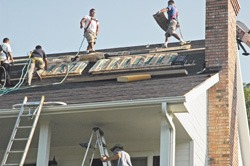Summertime Strategies Help Workers Keep Their Cool
by July 20, 2012 1:52 pm 115 views

With temperatures soaring above 100 degrees already this summer and more above-normal temps expected, local businesses whose work is chiefly outdoors are taking steps to protect their employees from heat-related illnesses.
Amy Jankowski, a meteorologist with the National Weather Service office in Tulsa, said a big high-pressure system parked over the central states caused the unseasonably hot weather in June and early July. The system then shifted toward the west, she said, providing a little respite, “but it looks like it’s going to try to build back up again over the central portion of the country.”
Normal daily highs for the Fayetteville area are 88.6 degrees in July and 89.1 degrees in August, NWS records show.
Jankowski said the weather service’s Climate Prediction Center is showing above-normal temperatures for Northwest Arkansas in both its one-month and three-month outlooks.
That means businesses like Springdale-based Foster Roofing make sure their workers stay hydrated and knock off during the heat of the day.
Jimmy Hall, a superintendent with the roofing company, said their crew leaders provide a cooler of water or Gatorade, whichever the crew members prefer, every day.
Also, the workers generally start their workday about 6 or 7 a.m., he said. They work until lunchtime, take three or four hours off and then come back and work until dark.
Hall said summer is the company’s busiest time of year.
“We kind of get accustomed to it,” he said. “We’d rather it be hot than cold.”
The job’s harder in the cold, he said, because “when your fingers get cold, they don’t work so well.”
Working in extreme heat requires simple common sense, Hall said.
“Just drink lots of fluids and don’t overdo it,” he said.
Trent Ragar, owner of the Scotts LawnService franchise in Lowell, said his company’s 17 employees are also starting their workdays earlier this summer.
“We changed our start time from 8 a.m. to 6:30 a.m., so they’re getting done about 2:30 or 3 p.m.,” he said. “It’s still hot, but it’s better than working till 5 p.m.”
He recently held a meeting with his employees to go over hot weather safety. The recommendations he presented included wearing a hat and loose-fitting clothes in “breathable” fabrics and avoiding drinks with caffeine like soda and coffee.
Workers were also given a brochure listing symptoms of heat exhaustion and heat stroke, and first-aid procedures for both.
Ragar bought an ice machine and water coolers for his workers, and ensures they get frequent breaks out of the sun.
“We make sure they have every resource they need to stay cool,” he said. “Basically we tell them to take their time, not rush it.”
At the University of Arkansas’ facilities management department, many jobs require outdoor work.
“The people at greatest risk are the grounds shop, who do mowing, cultivating, tree trimming,” said Miriam Lonon, the department’s manager of environmental health and safety. “Another group would be the labor shop, the people who do manual labor like moving stuff.”
Also, employees who work in the storage area of the warehouse and all the construction workers face risk from the heat.
The department’s summer safety strategy revolves around prevention, education and awareness, said Lonon, who has a doctorate in medical microbiology and more than 20 years experience in occupational health.
The department’s hours of 7:30 a.m. to 4 p.m. were set partly to take advantage of the cooler mornings, she said. Plus, crews have water readily available and are required to take frequent breaks.
Also, their trucks have placards that list symptoms of heat-related illness, in both English and Spanish.
Supervisors are particularly alert for signs of heat exhaustion or heat stroke, Lonon said.
“And then we encourage our folks to look out for each other,” she said.
